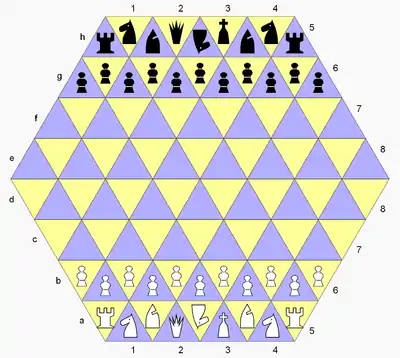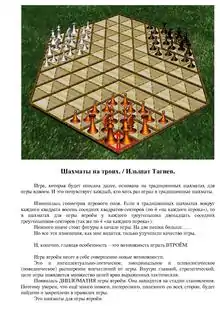Triangular chess
Triangular chess refers to a group of chess variants played on boards composed of triangular cells.

Triangular Chess and Tri-Chess gameboard and starting position
The best known is a chess variant for two players, Triangular Chess, invented by George R. Dekle Sr. in 1986.[1][2] Dekle made another variation including fairy pieces which is called Tri-Chess. These two two-player games were included in World Game Review No. 10 edited by Michael Keller.[3]

Guide to Ilshat Tagiev's three-player chess (click image for extensive pdf rules tutorial) (in Russian)
Russian Ilshat Tagiev, who introduced a "neutrality rule" to three-player chess in the mid-2000s,[4][5] took out a patent for a three-person variant of triangular chess on a hexagonal board in 2009.[6]
See also
- Hexagonal chess
- Trishogi—a shogi variant with triangular cells
References
Bibliography
- Interesting Engineering (2017). "Three Player Chess is Just as Crazy As it Sounds". InterestingEngineering.com. Retrieved 25 November 2018.CS1 maint: ref=harv (link) Cited in: .
- Keller, Michael, ed. (June 1991). "A Panorama of Chess Variants". World Game Review. No. 10. Michael Keller. ISSN 1041-0546.CS1 maint: ref=harv (link)
- Pritchard, D. B. (1994). The Encyclopedia of Chess Variants. Games & Puzzles Publications. ISBN 0-9524142-0-1.CS1 maint: ref=harv (link)
- Pritchard, D. B. (2007). Beasley, John (ed.). The Classified Encyclopedia of Chess Variants. John Beasley. ISBN 978-0-9555168-0-1.CS1 maint: ref=harv (link)
- Sohail, Umer (2016). "Three Player Chess Is Now A Reality". WonderfulEngineering.com. Retrieved 25 November 2018.CS1 maint: ref=harv (link)
This article is issued from Wikipedia. The text is licensed under Creative Commons - Attribution - Sharealike. Additional terms may apply for the media files.